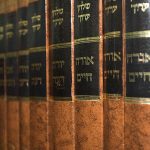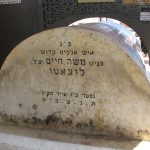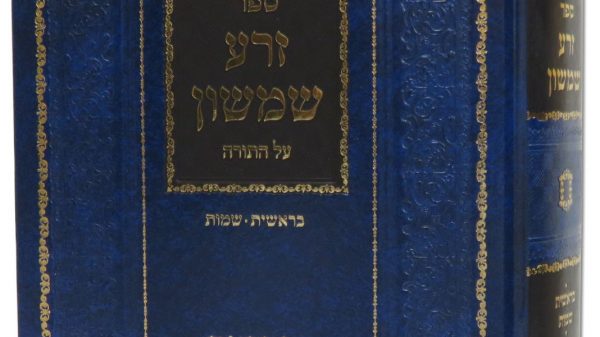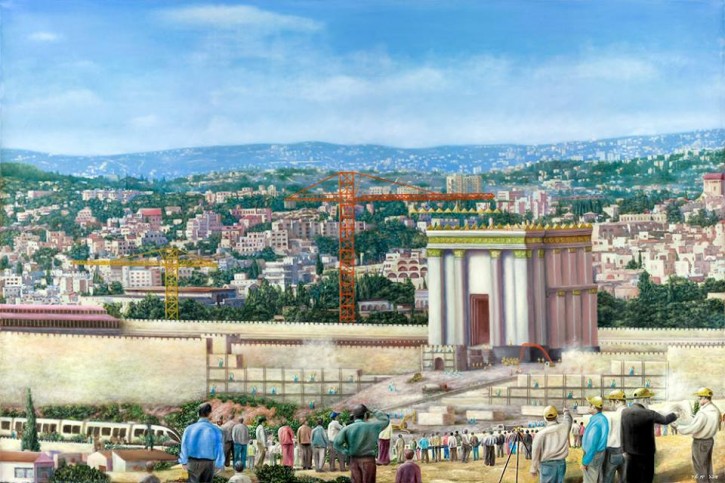Click here to download PDF
Divine Name in Reverse?
After Pinchas was awarded with being a Kohen there is a census of the Jewish people, but this time all the families are mentioned by name before giving the final number of the tribe. The families are mentioned with a prefix and a suffix. the prefix is the letter “Heh”- meaning “the” and the suffix is the letter “Yud” – meaning “of”. for example: HaChanochi – the [family] of Chanoch. Rashi on that very example (26:5) brings the Chazal that says “because the nations of the world would ridicule the Jewish people and say: ‘how can the Jews really trace their genealogy back to their tribes? Did not the Egyptians have control over their mothers? If the Egyptians had control their bodies (of the Jewish men) they certainly had control their wives!’. therefore, Hashem put his Divine Name of “Yud-Heh”, the “Heh” from this side and the “Yud” from the other side to say: I attest to them that they are the children of their forefathers. This is what King David says (Tehillim 122:4): “…. the tribes of “Yud-Heh” a testimony to Israel….” This Divine name of “Yud-Heh” attests to them that they are from their tribes that they trace themselves back to. Therefore, they were all written with a “Heh” at the beginning of the name of the family and a “Yud” that the end…..”
Why is the Divine Name of “Yud-Heh” the Name that attests to the genealogical purity of the Jewish people? why is it encoded in the family names backwards with the “Heh” at the beginning and the “Yud” at the end? Shouldn’t it somehow be encoded in its proper order?
Seeing More than Moshe?!?
In this week’s Parsha we have the story of the daughters of Tzelafchad demanding their rightful inheritance. the laws of inheritance were not clarified yet, and in response to their “question” the laws of inheritance are explained. but the daughters of Tzelafchad didn’t just come with a question – but with a claim! They ‘felt’ that since they are the only survivors of Tzelafchad they should get his inheritance, because if they’re not considered to be legal descendants then their mother must do “Yibum”! Moshe brought their case before Hashem who responded (27:7): “… correctly are the daughters of Tzelafchad speaking…” which Rashi explains: “.. so it is written in the Torah in heaven! this tells us that they saw what Moshe’s eyes did not see…. fortunate is someone to whom Hashem admits that he is correct” These words of Rashi are astonishing! It’s a basic tenet of our belief that Moshe was the greatest prophet of all times! how do we understand what Rashi says “their eyes saw what Moshe’s eyes didn’t see”?
The Neshamos of Nadav and Avihu in Pinchas’ Body
The Zohar in this week’s parsha (217a) says that when Pinchas did his Brave Act in front of the whole tribe of Shimon who were set to pounce and avenge their leader Zimri he expired from sheer shock and fear! The Neshamos of Nadav and Avihu inhabited his body and combined their souls with his and that’s what brought him back to life! [this Zohar is used to explain the ‘mechanics; of how Pinchas became a Kohen. He now had the souls of Nadav and Avihu who were Kohanim inside of him!]. the obvious question that needs understanding is what is the connection between Pinchas’ Brave act and Nadav and Avihu? Why was it their “Tikun”?
Kanoim Pogim Bo
The sin of Nadav and Avihu was their uncontrolled passion that caused them to take initiative when they shouldn’t have. they so wanted to serve Hashem that they ruled for themselves in front of Moshe (a severe sin) and brought a foreign fire that they were not commanded to bring. the common denominator between these two is the youthful passion that caused them to take initiative when they should have accepted the rulings of their Elder and not have initiated bringing this fire that was not commanded. The principle behind Pinchas’ action is the unique Halacha of “Kanoim Pogim Bo”- the zealots can strike him. it has very unique parameters that we do not find in the rest of the Torah. first of all, it is literally an act of zealotry. It is not the legally mandated punishment for someone who publicly commits adultery with a non-Jewish woman. the proof is that if he is tried after the act, he walks!! what demonstrates this point even more is that the Gemara (Sanhedrin 82a) says that the adulterer while doing this heinous act in public has the right of self-defense!! Zimri, even mid-act, had the right to kill Pinchas in self-defense! Pinchas was not acting as a agent of the law, he was a vigilante! what’s even more amazing than everything that we’ve mentioned so far: if the ‘zealot’ would ask a Rabbi, the Rabbi would not tell him to do it – it has to be a pure ‘act of zealotry’ coming from the Passion of the Zealot! The Gemara (ibid) says that when Pinchas saw Zimri doing the act he asked Moshe: “Did you not teach us that “the Zealot May strike him”? Moshe did not answer him directly, as it is prohibited to do so, he just said ambiguously “He who reads the letter should carry it out”. This Halacha of pure passion and initiative, that breaks all norms, that no Rabbi may order the Zealot to do, was the “Tikun” for Nadav and Avihu! their passionate initiative found its proper place in this scenario! assisting and becoming part of Pinchas was the proper place for the passionate initiative that cost them their lives. here it had to be an act of passion and initiative without getting a ruling from Moshe! This was their “Tikun”!
Passing the Torch to Yehoshua
By no coincidence, the story of Pinchas is the opening of the parsha where a fundamental change happens. Moshe ordains Yehoshua as his successor. this is a “game changer” in how Torah works. Moshe was the one and only prophet in history that was allowed to make Halachik rulings based on Prophecy. he alone was allowed to say, “this is the Halacha because Hashem told me so”. any other prophet after him for the rest of time cannot use prophecy as a means to interpret the Torah or issue Halachik rulings. from Yehoshua and onwards, if the Halacha was not clearly handed down from generation to generation, then we must figure out the Halacha using the principles that the Torah is interpreted with and by derivation stemming from comparing and contrasting whatever Source material is relevant to the question. this was immediately accentuated upon Moshe’s death. the Gemara says (Temura 16a) that after Moshe died many Halachos were forgotten. the Jewish people turned to Yehoshua to retrieve them from Hashem. Yehoshua said “the Torah is no longer in heaven” meaning that he cannot ask Hashem to tell him the Forgotten Halachas. it was Osniel ben Kenaz who reconstructed them with his reasoning. The principles the Torah is interpreted with and reasoning are functions of the oral law. the oral law has a duality to it. there are the Halachos that were taught to Moshe orally, that Moshe taught us orally, to be preserved orally, then there’s the aspect of the oral law that allows us to create new Halacha for the new questions that arise and gives us a license to reconstruct Halacha that was forgotten. in Moshe’s time Torah was “top-down”- from Hashem to Moshe and Moshe brings it to Earth and hands it to the Jewish people. from Yehoshua onwards, after the Torah has already been handed down by Moshe, “ it is not in heaven” and any ‘newness’ goes “bottom-up”. The scholars of the generation apply the principles, use the dialectical reasoning, and Hashem ‘endorses’ their findings. Yehoshua and Pinchas have a common denominator, Torah going “bottom-up”. Rashi brings the Gemara in Bava Basra that when Moshe ordained Yehoshua, Yehoshua only got some of Moshe’s light which the elders that generation described as: “the face of Moshe is like the face of the Sun, the face of Yehoshua is like the face of the Moon”. Leadership is being passed from “Sun” to “moon”. the sun is the emanator and the Moon is the receiver. Moshe served as spokesman for Hashem Who emanates all, and Moshe emanated Torah to us. Yehoshua is the “moon”, a receiver. He was the Prime student who never left the tent, absorbing every word. A new era begins and the “moon” leads! The receiver will now be the leader! In the new order for any question or doubt that arises the answer will not come down from heaven! Man, from Earth will have to raise up the answer, and if he “plays by the rules” Hashem will endorse the conclusions.
An allusion in the Rambam
This common denominator between Yehoshua and Pinchas is something that the Rambam took note of. The Rambam his introduction to his commentary of the Mishnah drops the hint. When explaining that from the time of Moshe onwards prophecy may not be employed for understanding Torah says the Rambam: “…prophecy does not help in analyzing and interpreting the Torah or in seeking any of the laws that are to be derived from the Thirteen principles that the Torah is to be interpreted with. Rather that which Yehoshua and Pinchas did in their analysis and learning is what Ravina and Rav Ashi did”.
The Name “Yud-Heh” – Man & Wife
We have mentioned time and again that the significance of the Divine Name “Yud-Heh” represents the entirety of creation. as the Gemara in Menachos tells us with the letter “Yud” Hashem created the higher realms and with the letter “Heh” Hashem created the physical realms. apropos to the hierarchy of reality, that the higher sustains the lower, just as the heavens support the Earth, so also the “Yud” which represents the Heavenly comes before the “Heh” which represents the Earthly. It is not a coincidence that the Hebrew words for male and female have a “Yud” and “Heh” respectively. “Ish” – male has the letter “Yud” and “Isha”- female has the letter “Heh” and in the integrated unit they are like soul from heaven and body from earth. Chazal say “his wife is like his body” implying that he is like her soul in the integrated unit. with this we could understand why the Divine Name “Yud – Heh” is the name chosen to attest to the purity of the of the Jewish families. The “Yud” of “Ish” – man never separated from “Heh” of “Isha”-woman and stayed faithful to each other.
Bottom – Up
This is all in the framework of going ‘top down’. in this week’s Parsha we are learning about things going ‘bottom up’ which means in the framework of the Divine Name “Yud-Heh” the “Heh” can take the lead! this is exactly what happened in Egypt! the men were sent out to the fields for hard forced labor from very early in the day until very late into the night. The Egyptians had free rein to try to take the Jewish women by force without their husbands anywhere nearby to stop them. the women took initiative and forcefully refused. this is why when talking about the family Purity the letter “Heh” is put at the beginning and the letter “Yud” at the end. The women took the initiative to fight back and refuse the Egyptians. As a result of them taking charge of their Destinies when their husbands weren’t at their side that’s what saved the genealogical Purity. It was the “Heh” fighting for the “Yud”! Therefore the “Heh” is at the beginning of the family name. The initiative of the women is what kept them connected to the “Yud” representing their husbands.
Intuition
All these principles are alluded to in the story of the daughters of Tzelafchad. it is the women, who represent the letter “Heh”, taking the initiative. they correctly derived the Halachah. When Rashi says “they saw what Moshe didn’t see” it doesn’t mean prophetic Vision. no one can compete with Moshe in prophecy! It means in their Mind’s Eye they calculated, and they intuitively felt that they were right. since it was a calculation and an intuition it needed to be endorsed as the final Halacha. the way Halacha was endorsing that generation was to bring it to Moshe. In subsequent Generations derived findings needed to be ratified by the Sanhedrin. In later generations it had to be ratified by the Mishna and Talmud. Ever since the Talmud was sealed, the new findings have to be ratified by the ruling being accepted by the Jewish people.
Women the Land and the Oral Law
Rashi points out at the Prelude of the story that this was the new generation that was going to go into the land of Israel. all the men of the previous generation had died but the women who always loved the land of Israel did not die! The daughters of Tzelafchad play out that female affinity for the land. we are taught in Kabbalah that the letter “Heh” represents the attribute of “Malchus” – Kingdom. a synonym for it is “Aretz”- land. just like Earth itself was created with the letter “Heh”, the land of Israel which is the holiest and most central part of Earth represents that attribute in particular. This explains the affinity of women for the land of Israel – they have a common spiritual root! Another entity that derives from this attribute of “Malchus” is the oral law (Tikunei Zohar, second introduction in “Patach Eliyahu”). Women taking initiative is parallel to the oral law ever since the passing of Moshe – we have to use it to take initiative to resolve our doubts and create new Halacha for all questions that arise.
Building the Kingdom
My Rebbe Maran HaGaon HaRav Yaakov Weinberg ZT”L Rosh Yeshivas Ner Yisroel used to explain that as women that are rooted in the “Heh” which is the attribute of “Malchus” – Kingdom this explains why the Davidic line was created by women taking initiative and trying to get the men to build it. whether it was done purposely and in a calculated way as Tamar did to get Yehuda and Rus to get Boaz or whether it just worked out that way by Divine Providence as with Bat Sheva and Dovid.
Chanukah Purim and Four cups of wine
This attribute of “Malchus” obviously refers to the Jewish Collective itself – the kingdom per se. The “Woman” in Shir HaShirim is Klal Yisroel! That is why the women are Central in Saving the Jewish people and thus causing the Rabbinic (Power of Oral law) holidays and all Rabbinic laws commemorating saving the Jewish people. it’s all the power of the oral law! Yehudis on Chanukah, Esther on Purim and the righteous women in Egypt. They saved the Jewish people and were the catalyst for the Rabbinic holidays of Chanukah and Purim and the Rabbinical laws that go along with it. although Pesach is a Biblical holiday, there the Rabbinic Halacha of drinking the four cups of wine seder night. women are obligated in that law because they made the miracle! this is the Halacha of “Af hen hayu b’oto haness” – they were also in that miracle. Rashi brings from his teachers that it means they were the main part of the miracle as they Esther, Yehudis, and the women in Egypt, brought about the salvation.
The Three Weeks
This is the message of Hope for the three weeks. Although we lost Moshe and the Torch passing to Yehoshua who is no by no means on the same level, it’s like the difference between Moon and the Sun. Nonetheless, we are assured that the new leadership will work out! We will always remain connected and will always find truth. We will generate it from within ourselves! as Hillel said when he forgot the Halacha when Erev Pesach comes out on Shabbos: “Leave it to the Jewish people, if they’re not prophets they are the children of prophets”. Hillel didn’t mean prophecy literally, prophecy cannot be employed in halacha ever since the passing of Moshe. He meant like Pinchas and the daughters of Tzelafchad – they will intuitively see the truth! this is the message of Hope for this long and bitter exile. even though the generations get smaller and smaller in spiritual level and intellectual Acumen we could be assured we will always remain connected and we will always find the truth and Clarity that we need.










